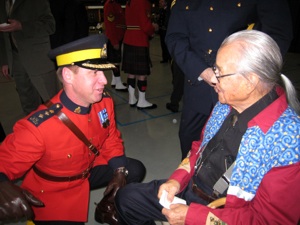My Blog
OLD CAN BLOGS
WE NEED A GREAT NOBLE CHANGE
said 94 year old William Commanda in March 2008
Hi Folks!
We make a fresh attempt at blogging this snowy weekend (March 7 - New Moon - the Elder is confined to quarters and can not make forays into the outside world, so we shall do some reflecting instead. (A week later, we report that it has taken us a good chunk of time to do this one blog!)
Well, William, I said, we really have to start working on our blog!
What do you mean, we have to do a blague? replied our tongue in cheek Squirrel Elder, whose second language is French.
Really, William, it’s not a brag!
At our 2007 Circle of All Nations Gathering last August, one young woman told me she had enjoyed reading our July entry, and was looking forward to the next - sadly that was our only blog for the year! As usual, William Commanda’s demanding pace of activities left us with no time for regular reports and reflections on his activities.
Now, we try again, and we hope this effort will keep you tuned into the ongoing interests of our ninety four year old.
We would love to hear your thoughts about this blog - please email us at circleofallnations@sympatico.ca
Circle of All Nations
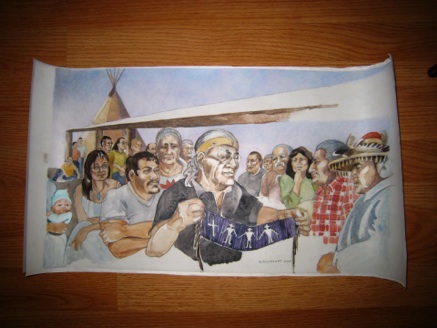
by Beatrice Multhaupt
Writing
But, that is not to say that we have not been writing. In November, barely a minute before his ninety fourth birthday party, we printed a draft copy of Learning from a Kindergarten Dropout Book Two. It is largely a description of his key activities, passions and perspectives of the past three years. It also includes a graphic presentation of his vision for the Sacred Chaudière Site and Victoria Island. We hope to finalize it within the next few months. We also printed a photo album of life on Bitobi Lake for William’s birthday - some of you may know that entirely out of the blue, William insisted on buying me a kayak last summer, and I spent hours exploring the amazing lake that thousands of people descend upon during the annual Gathering, the beautiful lake that our Gathering security team works hard to keep folk off! This was my first intimate experience of the lake, and I was blown away. I took countless photographs, because I wanted William to see all the corners and creatures of his lake. The lake lived within me over the winter, and now takes life in another form - a photo journal, the last draft journal entry having been finished last night!
You will recall that a passionate care for Water has been at the heart of much of William’s work over the past few years. In 2004, the key theme for the Circle of All Nations Gathering was Respect for Water, and many folks shared ideas for innovative water stewardship projects; in November 2006, we organized a WaterLife workshop for folk in Ottawa. At this time, we were deeply convinced that people would find many answers to their own problems and development by returning to the source, and our workshop included a special sacred ceremony on the Ottawa River, at the ancient meeting place on Victoria Island, as close to the the Chaudière Falls as we can get, to inspire such spiritual growth. Peter lit the sacred fire in the cold winter night under the watchful eyes of the Full Grandmother Moon, Monique, Heather and other grandmothers reminded women of their special relationship and responsibility to the spirit of water in a moving ceremony; and we included a workshop on Elena’s river art, to encourage people to find their personal paths to their own creative potential within nature. This was a deeply meaningful part of the workshop for most participants.
With the gift of the kayak, Grandfather was reminding me of this promise of the water, and indeed, the season on the lake was a tremendously meaningful experience for me. But in the winter, I realized I needed to go a step further, and share my insights with others. The indigenous storyteller tradition and talking circle is all about sharing one’s discoveries and enhancing the evolution of the group - a bit different than the “knowledge is power” theme, so guard it. Of course, it takes confidence to reach the stage of realizing one might have something of significance to share - but this is what the Circle of All Nations experience is all about - learning to take one’s rightful place!
All that to say, we have another book almost ready to share with you too - Sacred Waters - Butterfly Kisses!
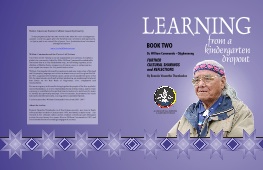
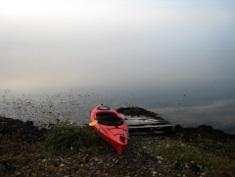
Communications and Outreach
So yes, our priority this year is to develop our Communications strategy and skills! The stars lined up to usher us into this phase of activity almost as soon as we conceived it, after a hectic Christmas season. I shall share a few of the interesting moments of the past months with you now.
Early in the year, William was interviewed by Mandy Fraser, from Manitoba, for a joint community justice project for the Centre for Education and Work, Manitoba Justice and Manitoba Keewatinowi Okimakanak First Nations Justice Strategy - an interview to be broadcast across Manitoba. This was of special interest to me, because, a decade ago, I had been involved with the early work of the MKO Justice Strategy, and I was pleased to review their website and see the work being undertaken now (www.cew.ca). Then William was invited to do an interview for Rogers Télevision (TVR 23) for Pour tout l’amour du monde, a one hour show in French, hosted by Ginette Gratton - we are sure this was a big treat for his Francophone friends, (who might also be interested to know that there’s an interview with our elder in the December issue of VIVRE, Le magazine international pour améliorer sa qualitié de vie.) And, further to a presentation on the vision for the Indigenous Centre at Victoria Island at the summer Imagine Ottawa workshop, I was interviewed by Giacomo Panico about our work on his CKCU FM Radio Show.
Art, Spirit and Creativity


The next special moment came with the launch of the Daphne Odjig art exhibition at the Museum of Civilization on January 16. Elder Commanda had been invited to do the opening prayer. This was a particularly special evening for me - in January, twenty years ago, I had received the Odjig Comforting piece from the Homage to Grandfather Suite - it had anticipated that William Commanda would occupy his grandfather suite in my home a good ten years later! And now, a decade further on, I was to be in the presence of these two amazing indigenous leaders, in an the one indigenous space within the capital of Canada, where the spirit of the art of another of our national icons - Douglas Cardinal - draws the world!
The Museum of Civilization was taken aback by the great interest in the Odjig Exhibition, and had to move the launch to the Great Hall - and even there, the attendance was greater than had been anticipated.
Are things beginning to shift? Is something happening in Canada, without us really realizing it? I know I felt with the recent identification of the Seven Wonders of Canada that it was becoming patently obvious that the spirit of the indigenous heart was directing the deeper instincts of the nation - the canoe, the natural wonders that Our Elder keeps reminding us we have to respect and honour, and even the All My Relations multicultural pier in Nova Scotia were all there. And, intriguingly enough, it was the Sleeping Giant mountain that received the most votes. The spirit of Rock and Mountain is already embedded in our collective national psyche.
The Odjig exhibition was the fifth major profile of the work of Indigenous artists in Ottawa: there was the National Art Gallery Norval Morriseau Exhibition, shown barely before he passed away (did you know his brother Wilfred actually lived with William for two years?); then there was the Robert Davidson Exhibition (together with the stunning Haida Mask dance performance); and the “In My Lifetime: Contemporary Aboriginal Art” exhibition, at the Museaum of Civilization where, amongst other things, we learned about artist Sonia Robertson’s exploration of the inaccuracies of history, and the meaning of territory and place to Aboriginal inhabitants, drawing on her mixed heritage of Innu and fur buyer blood: using the idiom of wampum belt, she “weaves poetic passages through history and memory to dispel the inaccuracies and to create a new alliance for the future...Refaire l‘alliance functions as a contemporary wampum belt. Historically made of quahog shell, wampum belts served as documents that recorded alliances, important events and agreements among Aboriginal nations and with European newcomers ... Robertson poetically considers the myriad possibilities of interwoven relationships in Canada’s future. The beaded belts become a poignant prayer” (Au Fil de Mes Jours - Commissaire: Lee-Ann Martin - Musée National des Beaux-Art du Quebec); and finally the Dè T’a Hoti Ts’eeda: We Live Securely by the Land Exhibition of rare 19th century Dene artefacts at Carleton University. (Amongst the many pieces there, one artist reminded us that General Amherst was the propagator of germ warfare against Indigenous Peoples even as the ink on the Royal Proclamation of 1763 was drying.)
William Commanda was at all of these exhibitions!.
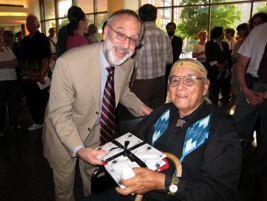
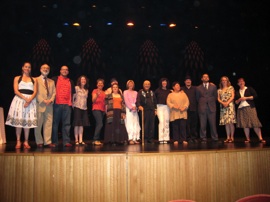
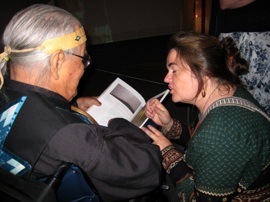
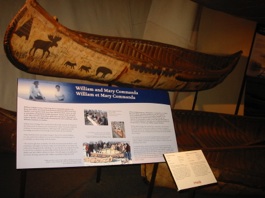
Then there was also the Evolution of the Pow-Wow Art Exhibit featuring the work of Mary Ann Caibaiosai - and this one included a watercolour painting of William himself! And here his William being serenaded by his Dene artist friend and telephone buddy, Brad Henry!
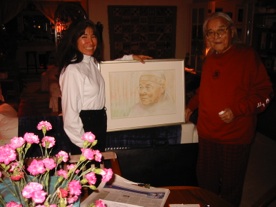
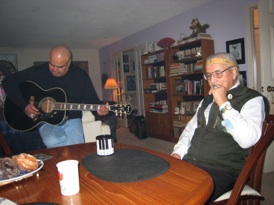
Are artists the first to sense the dawning of a new energetic force? William, the world reknowned canoe maker whose crafts, (in both meanings of the word!) generally carry the special signature of stencil art, has been expressing his creativity, spirit and heritage since his early teens. In 2000, several of his canoes became part of the permanent exhibition at the Canadian Canoe Museum, and the bilingual documentary by Valerie Pouyanne, Good Enough for Two, explores his canoe making skills, intermeshed with his philosophy and vision for life. A few years ago, we had a gripping experience with the Seven Fires Wampum Belt - William was sharing its messages in the Museum of Civilization with Architect, Douglas Cardinal, (the visionary indigenous architect who created the groundbreaking space,) together with First Nations Peoples from Batouche, New Brunswick, under the glorious painting by Alex Janvier, entitled Morning Star (you will recall that this is William’s native name - Ojigkwanong). William’s smudge stayed burning throughout the long session, and we were all uncontrollably moved to tears. Now I have heard William talk about the Wampum belts on countless occasions, but there has not been been one with quite that same combination of art and spirit energy - I am always moved to see the Belts, but not often moved to tears like that. Certainly one could feel the power and spirit of ancestral and Great Mystery energy join with us in that moment of reverence. Was the current wave of expression and acknowledgment of indigenous art in the capital city being anticipated at the ancient meeting place within the heart of the country?
Just imagine what will happen in in the National Capital Region when the Indigenous Centre on Victoria Island is able to showcase First Nations, Inuit and Metis art, crafts and creativity! Indigenous Peoples will not be marginalized and made invisible in the land of their ancestors any longer, and we will all be to take our rightful places under the sacred tree in this land, as prophesied by Lakota visionary Black Elk.
On June 21, 2006 young artist William Salvatore presented William with his painting, Chief Commanda Dances - it is a marvellous promise of mocassined feet dancing around the Sacred Chaudière Falls. Our young drummer and dancer Theland Kicknosoway is awaiting that moment eagerly!
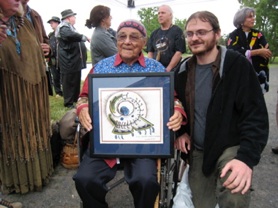
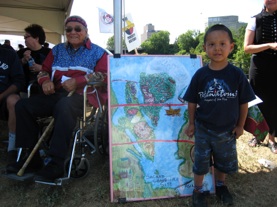
Uranium, Environmental Stewardship, Wampum Belts and Land Issues
On January 26, Lawyer Michael Swinwood invited Elder Commanda to a community feast with Ardoch First Nations and Settlers from the area, many of whom were involved in the uranium protest in the Sharbot Lake/Ardoch area. The Elder was asked to make a presentation on the Sacred Three Figure Welcoming/Sharing Wampum Belt that he carries. He talked about how, in the 1700s, before the continent was divided, his ancestors on the east coast, the first to meet with the newcomers, had made an agreement to share the grand natural resources of their homeland and their values in three equal parts with the Europeans; the fact that this was a sacred commitment was signified by the symbol of the cross, which represented the Vatican. He talked about how the spirit of the agreement had never been honoured by the newcomers, and he talked about the subsequent impoverishment and oppression of the original peoples, and the pollution and destruction of so much of their land, waters, trees, medicines, and animals. He also asserted that the way to resolving matters was though education and peaceful intervention.
Now many of the newer occupants of Canada come from oppression and suffering in their homelands, and Canada is seen as the land of hope and opportunity - and rightfully so, but surely not at the continued cost to and marginalization of the First Peoples - and all they valued, developed and nurtured in this country. Already, we begin to see the many irreversible costs of development over the past century. It is in our own best interest to understand the history of this land.
Over the years, Dr. Commanda’s tireless efforts to present the stories of the Sacred Wampum Belts and the true history of his peoples has been awakening the hearts and minds of many people. They resonate with the heart because their simple yet profound messages are undeniable. The group of people at the Maberly community feast included Algonquins who had always lived in communities off-reserve (and suffered racism and exclusion in differing degrees from both Aboriginal and white communities), and Settlers, as they have come to call themselves, the more privileged occupiers of the land. Now they are increasingly unified in face of the threat of test drilling for uranium on their doorsteps, and many environmental activists are in support of their efforts to express their concerns in a domain historically dominated by the will of corporations and governments. In response to their requests, Elder Commanda had joined them in prayer and ceremony on four occasions over the summer, and this matter is described in our first blog entry. The update on the file is the harsh coming down of the arm of the law against representatives of the Ardoch First Nations. In a judgement by Justice Douglas Cunningham on February 15, AAFN negotiator Robert Lovelace was sentenced to six months in jail and fined $25,000 for his participation in the peaceful protest against uranium exploration on Algonquin traditional territory; co-chief Paula Sherman was fined $15,000, and the Ardoch First Nation community $10,000. This is really a global debate over legitimate property-rights concerns, indigenous concerns, and undeniable environmental concerns, and it is a grave matter that the judiciary has weighed in in this repressive manner. Elder Commanda smokes his pipe regularly and send his prayers to support and strengthen the people at this very difficult time. His prayer for the protection of Mother Earth and the waters from further abuse and exploitation is ceaseless. And, yes, it is difficult and painful work, and we need deep wisdom to help us find the path to a new peaceful and healthy tomorrow.
Social Justice
By the week of January 28, the nation, it seemed, was devastated by the news of the deaths of two young children on the Yellowquill Reserve in Saskatchewan. It was particularly sad for me - I had worked as parole officer on the reserve, then known as the Nut Lake Reserve, twenty years ago, and had witnessed the impacts of the residential schools, poverty, substance abuse, religious and spiritual struggles, internal community tensions and the overt and systemic racism smothering them. The cultural isolation evident then is just as oppressive now - surely the bitter irony of the nomadic people confined to small, poor chunks of land, while the world moves in to occupy, exploit, and, (as we learn daily in the news about the environment), destroy the rest of their birthright and heritage, surely this irony cannot not be lost on all. I remember watching a documentary on CBC recently - Brian Stockton’s The Saskatchewan Trilogy: quite impressive to my ‘CanLit’ mind, but deeply disturbing to my conscience, as these lines rattled through my head: “Both my grandparents were given free land in Saskatchewan”, and “My grandparents gave me the unique and irreplaceable gift of Saskatchewan.” Whose land? Surely we have to reexamine the history of our heritage? Surely, we cannot live the good life mindlessly, at the expense of others forever - some would say that it is this that eats the soul and spreads the cancer.
Asinabka - The Sacred Chaudière Site
On January 30, several supporters of the Vision for Victoria Island - Dan Gagne, Phil Weir, Jeremy Wright and myself - amongst other civil servants enthusiastic about it too, participated in a planning workshop organized by the National Capital Commission, and promoted it to a group of sixty people - there was a great deal of interest in this comprehensive and far reaching dream for the Jewel in the Crown. We already knew there was massive grass roots interest; this showed things were moving in the right direction. We plan to do a presentation at the NCC Board’s April 3 Public Meeting.
This is a synopsis of the vision:
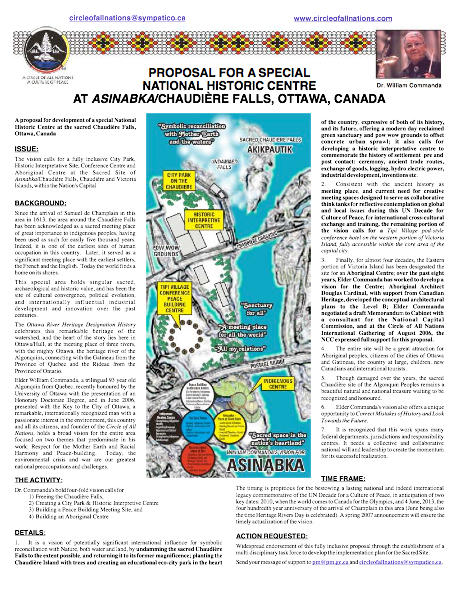
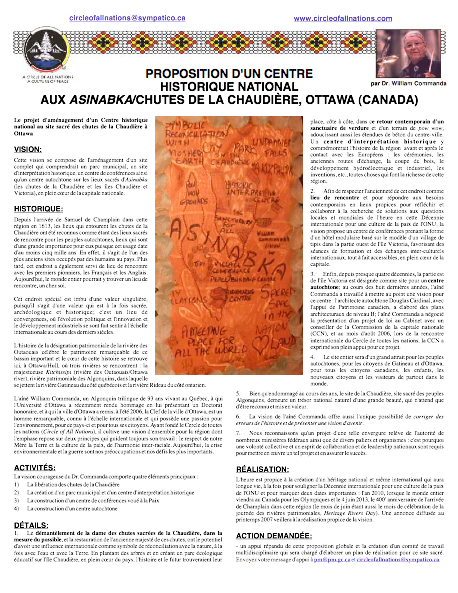
We hope you will add your voices in support.
Sacred Wampum Belts
As the February Bear Moon approached, the Wampum Belts took centre stage - a group of Parks Canada employees came to visit Elder Commanda with a white wampum belt. It was beautifully made, a modern construction using old wampum beads, depicting a pipe in purple against a white background. The elder decided to bring out his three Sacred Wampum Belts - and their presence in the room was electric. The Seven Fires Belt absolutely sparkled with life - this was so evident to me, I was awed - we generally get to see them by themselves. This time, in the presence of the other belt, the Elder’s belts revealed their vitality in no small measure; this was also readily apparent to our guests. Now I began to understand the depth of the elder’s message when he talks about his belts being live belts - unlike those stored in museums, which are without teh same life and spirit. His belts are smudged, prayed upon. honoured, pondered, studied, held in the heart and loved. And this day, even strangers could see that they spoke volumes.
Policing
From the ancient to the most current: Elder Commanda participated in the Royal Canadian Mounted Police Change of Command ceremony, as Chief Superintendent, Allen Nause, took the reins as Commanding Officer “A” Division in the capital city. So, after former Ottawa Police Chief Vince Bevan presented Elder Commanda with a police cap the day he received the Key to the City of Ottawa in June 2006, and symbolically put him in charge of security within the national capital region, the Elder went on to offer the blessing when Chief Vern White took over, and now he was offering prayers to guide the national police! What a change it seemed to me in terms of my old work in policing: when I worked in Aboriginal Policing, justice inquiries in every province and territory revealed that Aboriginal Peoples were badly served by an institution marked with systemic and overt racism. William is not unaware of this history either. And this week’s W5 documentary explored how Alain LaRiviere’s life was devasted by police entrapment. I thought about our friend Donald Marshall Junior, the pioneer in the struggle for truth and justice, following his wrongful conviction: it took two justice inquiries to reveal the truth in his case; and now, with the work of the Lawyers for the Wrongfully Convicted, we are learning more about justice travesties. I remember years ago proposing a workshop on the victims of the criminal justice system for a Victimology Conference, but idea did not go far. How other than by shining the light on our shortcomings and errors can we hope to remedy and transform them? The recent commentary around New York Governor Spitzer’s public apology over his conduct has been interesting - mainstream analysts focus on damage control. William talks always about forgiveness - you have to forgive yourself first for your failures and wrong doing - and in order to do that, you really need to examine your actions so you know what it is you need to forgive yourself for. Then, he says, you can forgive others, because you know of the transformative power of forgiveness. Over the past decade, police have been making efforts to change some of their patterns and practices, but this has not been an easy challenge. The Robert Peel view that the police are the community and the community the police is increasingly difficult to realize in communities of great racial and cultural diversity, social differences and new criminal activity. There is no one face police can wear as they undertake their grave responsibilities in increasingly complex communities - we want them to be tough for the bad guys, but friendly for us good guys - no easy challenge. William prays deeply for enlightenment, because he knows there is a deeper value base for effective problem solving and peace building within his Circle of All Nations philosophy, and we hope with his prayers he has planted the seeds for the kind of peacekeeping that will serve his people and all others well across this country. As Mi’q Maq elder Alex Denny once said to me, We have no word for justice. What can it mean to have developed societies like that? That is where the pot of gold lies. It is something that world renowned German psychotherapist Bert Hellinger grasped immediately when I shared it with him: this was a markedly different worldview, and, further, one that could help the western world problem solve differently. In fact, his years of work with the Zulu peoples in South Africa played a significant role in the development of his family constellation therapy work. Ideas of this nature sparked under the umbrella of Aboriginal Justice in the nineties, but sadly, were stifled, and have not yet had the opportunity to evolve.
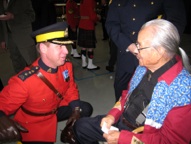
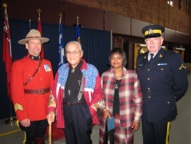
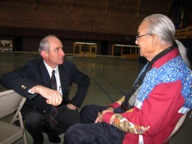
Of course, William reminds me that his personal relationship with the Mounties has been generally positive and colourful: in the old days, Victor Maloche and other Mounties used to visit William regularly; they came in uniform and impressed the children of his American friends; once William loaned him his Buick Roadmaster for a week when Victor Maloche went off to a wedding - you see the Circle of All Nations approach was embedded in his style all along. In fact, at the Change of Command ceremony, retired RCMP Officer Dawson Hovey came to greet the elder and talk about his canoes and snowshoes from the seventies - William has been known to the cops for quite a while! In fact, on William’s wall at home, there is a photograph of a very thin William showing RCMP officers some snowshoes he was making - who are they for, he was asked; for me, he answered. They shook their heads sadly: at this time he was under a hundred pounds, and was believed to be dying of cancer. And of course RCMP Officer Wayne Russett has been supporting Williams’s Circle of All Nations work over the past decade. Again, it was startling to realize how many people William has connected with over the years. It’s that spirit of Ubuntu again!
Water Ceremony at Victoria Island
On Saturday, February 9, in the middle of a steady snow fall, William joined Monique Renauld and over sixty women in an annual Water Ceremony in honour of the Bear Moon at Victoria Island. Bundled up in countless blankets in his wheelchair, our ninety four year old participated in a moving ceremony of drumsong and prayer honouring the spirit of water; there were a few First Nations women, most were of mixed blood, some were French, and were several young girls and boys; a few men stood around in support of the women. Brian lit the sacred fire. Indigenous Peoples teach that women have a special relationship and responsibility to water, associated with the menstrual/moon cycle and childbearing and birthing, and they are guided by Grandmother Moon, who manages the movement of waters over Mother Earth. In what has become an annual ceremony under Monique’s leadership over the past seven years, more and more women bring their prayers to the Sacred Chaudière Site in support of the Vision for Victoria Island and the Mighty Kichisippi. As we stood in the cold wind, we were joined first by eight homing pigeons, and then thirteen crows. Later as we left, Dean spotted another silent observer on the island, within Nature’s own Medicine Wheel.
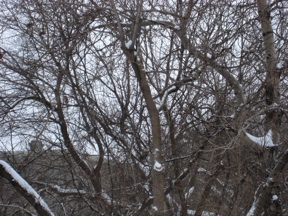
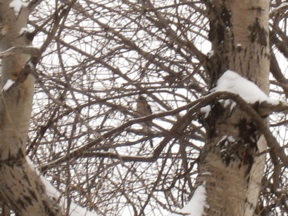
International Linkages
William’s next guest hailed all the way from Kazakstan originally. A member of the spiritual School of Anfesa, Mira Akayeva’s friends from home had learned about our special elder, and they identified him right away an important holy man with a crucial message for the world. We learned that as a part of the former Soviet Union, during the communist regime, religion was outlawed, and this left a deep spiritual gap in the psyche of many people. Now, they are reclaiming this old heritage, and many are finding that the closest links to the spirituality they remember lies in the earth based ideology and practices of the Indigenous Peoples of North America. Hence the passionate outreach to our elder, particularly with respect to their concern about water.
Then Grandmother Margarita from Mexico came to dinner. A remarkable Spanish speaking elder who does not let our two official languages stop her from communicating intimately with everybody over here, Abuela Margarita has been coming to Grandfather’s Gatherings regularly over the past seven years, bringing a remarkable energy, wisdom and humour to the events, and a passionate support for the Vision for Victoria Island.
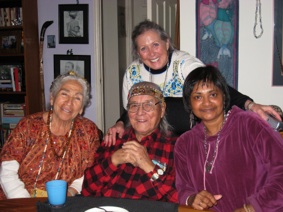

No, these are not international guests! - it is our elder with his youngest drummer friends, Misko and Theland, at the Odawa Native Friendship Centre Children’s Pow Wow, where the First Children of the land dance their greetings to the spring on the concrete floors of a grey gym.
Two Important Documentaries:
Les Peoples Invisibles and Unrepentant
On one of the coldest nights in Maniwaki, we ventured out to the movie theatre - to see Richard Desjardins’ eye opening documentary on the Algonquin Peoples - Les Peoples Invisibles. William was moved to see this graphic portrayal of the history of his people - the ‘rendering them invisible’ so that their lands and resources could be exploited without compunction. Valerie Giker, from the Zoom 15/35 Youth Table and Julie Mercier from the Maison de la Culture de la Vallèèe-de-la-Gatineau organized a panel presentation after the screening, and it was very encouraging to see the new generation actively facilitating dialogue on a most important and at the same time very difficult and divisive subject - an attempt to bridge painful pasts and cultural divides, and build for healing, reconciliation and strengthening of inherited ties and relationships. Both Algonquin Tribal Chief Lucien Wabanonik and Social Worker Cecile Ratt and others provided important indigenous perspectives to advance the discussions.
Verna McGregor just gave William the documentary Unrepetant - Kevin Annett’s passionate indictment of the United Church’s ugly Residential School legacy. Some 50,000 native children died in residential schools across the country during this shameful era in Canadian History; the pain is obviously still raw for the survivors and victims of the traumatized families, and the stories lie throbing within living memory.
Both documentaries are must sees for Canadians everywhere. It is so encouraging to see the history of the First Peoples being examined by young Canadians, as they shine the torch on the country’s darker secrets. All these things must see the light in order that their darkness can be healed, and a new life commence for future generations. As William says, we have to learn to forgive ourselves for wrongs we may have committed, and in order to do that, we have to examine our history honestly. Then we clear the path for healing and new growth.
The Universe and Grandmother Moon
Likely for you as well as for us, this year, with the Chinese Year of the Rat, and the start of its whole new energetic cycle, the Leap Year, the special solar and lunar eclipses, has drawn our focus upon the larger universe.
The power of the energies of the past visited us, when, in the middle of a snow storm, writer William Sullivan arrived from Massachusetts. William had written The Secret of the Incas - Myth, Archaeology and the War Against Time, having determined that the mythology of the peoples of the Americas are encoded with detailed information of the solar system and the cyclical movement of time, and he was now on a search help the Narragansett uncover the mysteries behind Anishinabe stories of animals and topography. Fascinating! No wonder Alonzo Commanda, William’s father, had such a reputation for being able to find his way anywhere in the dark, could anticipate season and climate changes, and Uncle Gabriel Commanda was able to lead the trail into the riches of Val d’or.
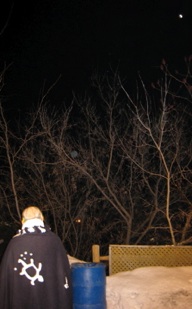

On February 20, we celebrated the Lunar eclipse with a pipe ceremony. A beautiful red moon emerged from her dark robes and traversed the heavens, as thousands of people watched the grand show in awe and respect. Ironically, this was also the day the US rogue satellite was blown up in space, and its tons of deadly poison discharged into the atmosphere and ocean. There was applause for the hit. We could not help thinking how mindlessly we were now contaminating the great ocean that Grandmother Moon sails upon, much as we have done Mother Earth’s oceans, rivers and lakes. It was only a year or so ago that Environment Canada was beginning to worry about the World War Two weapons dumped into the Pacific Ocean on the BC coast; these were now beginning to erode and leach into the water, but moving them was presenting its own hazards, and the scientists were finding no easy solutions to the problem. Sixty years ago, Indigenous Peoples under the lead of the Hopi took a strong message to the United Nations concerning the environmental degradation that was ensuing in their world - but they were ignored. Environmental crises mount. Just the other evening we learned about the high levels of fertilizers, drugs and birth control compounds in the water supplies across much of the United States - compounds which are also destroying the reproductive systems of fish; a few weeks ago, William was really upset to see a similar show about frogs in Ontario, remembering the decrease in the frog songs at his lake over recent years - why, only a few years ago, we would head down to the tent to sleep at the water’s edge at his lake, only to head back to his home after a few hours, because those noisy frogs would not respect the midnight ‘lights out and silence’ now rule! You can scarcely imagine how painful it is for him to note the changes in his country over the past century.
All the more we need the power of Grandmother Moon to raise the spirit and strength of water.
Grandmother Moon and International Women’s Day, Women and Culture
As I said earlier, Indigenous peoples remind us of the special relationship women share with Grandmother Moon. The Moon draws attention to the special and unique power of woman, and her cycle of procreation. This was something that was respected Indigenous societies, and traditionally women held powerful decision-making positions since they were primarily responsible for the survival of future generations. In our book, Learning from a Kindergarten Dropout, we reflected on differing attitudes to moon cycles, and child rearing; Elena reminded me that for European societies, two thousand years ago, the Red Moon, (the lunar eclipse) became associated with idea of women being unclean, and ushered in many different forms of oppression and inequality. We have not yet shed that negative legacy.
The glorious Red Moon of February reasserted her indomitability. March 8 was International Women’s Day, and Irene Compton from the Minwaashin Lodge - Aboriginal Women’s Support Centre invited me to join a panel of women to present a multicultural perspective on women’s issues. They say a people are never down till the spirit of woman is broken. Women shared many powerful stories of survival and celebration that day, and it was an inspiring experience for all.
It was difficult to know which cultural box to fit my self into. As I sometimes say jokingly, it is difficult to describe who I am: I am Indian, but I am not from India; I am South African, but I am not African; I am an Indian in Canada, but I am not a Canadian Indian; Am I just Canadian, or am I Canadian? Well, it was more difficult to figure out what kind of woman I was!
In the end, though, I realized I had learned different things from different parts of my strange heritage and these have contributed to making the woman I am - out of many heritages, values have melded into one - consistent with the dream of a Circle of All Nations.
With my rootedness in the East came respect for Mother India, and the Mother River Ganges; in Indian mythology, both Goddesses and Gods were powerful; Animals were intimately connected with Gods and Humans, and were the integrators and teachers; Buddha reminded me about self-reflection and self-improvement; and what can I say about The Mahatma Gandhi: There is No Way to Peace - Peace is the Way; (William makes me watch the Gandhi three hour documentary periodically so that I can support his work properly - and the Elephant I have slept with since I was a baby comes directly from the Gandhi family!) But there are also two disturbing issues that preoccupy me with respect to women’s issues - when a girl is born, she is seen to belong to the family of her future husband, so she grows ups with a sense of ‘not belonging’; and her family has to save for her dowry, so there is the issue of comodification of woman. An Indian woman talked about these being two key factors that have impacted on the position and power of Indian women. When I was two, I visited India, and swung on the neck of my artist great uncle as he painted, sitting cross legged on the earth. I learned a little about my eastern spiritual heritage at a Yoga Ashram run by Jews. I have much more to learn.
I was born in South Africa, and grew up under apartheid. This regime of racial oppression impacted all our lives, no matter where on the proverbial totem pole one stood. My mother taught all my life, she was a musician, tennis player, dancer and my father considered her an ‘All Rounder’ - I grew us with a solid personal sense of woman’s equality and potential. My father was a feminist - in his school, the sport teams were all named after women. But the South African heritage was also about having servants. The family lives of African peoples were disrupted as men were taken to work the mines; their wives moved to the cities, and worked, amongst other things, as domestic workers and nannies - leaving their children abandoned in the villages, while they raised the children of others in style and with care. This reality of course eroded traditional family structures and gender roles, and has confused many children all races. But the strong women of the Motherland have ensured her transformation, and today, the Gogos, the Grannies, carry the future in their arms. Strong women from my home land have always inspired me, and my sister Beulah’s book, “the face of the spirit” celebrates many of their stories of courage against all odds.
I have lived Canada since 1970. During the first decades of my life here, I lived the life of the west. I studied English and Canadian Literature, and got to know this country through those lenses. I worked the in the criminal justice system across the country, in a range of capacities, and at that time, it used to be strange to find women, let alone Indian women, working in prisons. For a period, I was consciously a career woman, and reasonably successful. My family was multi-racial, and I lived all the social issues communities are addressing now thirty years ago. I still have my years of Glamour magazines; I gave away my gucci watches. I remember traveling to South Africa via Israel one year, and thinking of the people on the El Al Flight, look, I am like them - they look and sound like something I remember deep inside me; at the same time, I felt like I was one of the golden people of North America.
It was my work with Aboriginal Peoples that brought me the true gifts of the North, and deepened my life immeasurably. I remember one Grandmother telling me that she taught her daughters to respect themselves - I thought how profound - I was taught to respect my teachers, adults etc - but if you respect yourself, it follows that you won’t do things that would be disrespectful to others. It was when I was on the Task Force on Federally Sentenced Women that I saw the strength of Aboriginal Women; in an initiative dominated by the federal government and Elizabeth Fry Society, they asserted their right to their equal place, and they brought forward the most innovative idea to a punitive prison system - the vision for healing. Remarkable Aboriginal women, from within the infamous Prison for Women, and outside, elders and educators, and lawyers, worked together, coming out of the same cloth of deep pain, through moments of anguish to deliver the vision for a healing lodge from memories of the society that Elder Alex Denny talked about, where there is no word for justice, where if people did wrong, they were deemed to be in need of teaching, or in need of healing. Indeed, there are many things that I have learned about and from Aboriginal women that have enriched my life. Yet too many are the most abused, oppressed and impoverished in this country, and we all have a tremendous responsibility to transform this reality.
This year the Governor General hosted a meeting of Aboriginal Women to commemorate International Women’s Day, and to identify cultural emblems of significance to their communities.
Verna McGregor and I thought Algonquin artist Janet Kaponicin’s painted birch bark depiction of tragic story of a young Algonquin maiden might be the most meaningful one in the capital city. This is a synopsis of the story, still held in the living memory of many Algonquins:
The Spirit Behind Parliament: “The painting is about a true story that took place behind the Parliament buildings. It was when they started to clear the land for the soldiers’ barracks. The natives were camped by the river in their fall hunting camp, below where the Parliament buildings now stand. They were talking about the damage being done, since most of the trees were being cut down and there was so much mud everywhere that boardwalks were being built among the soldiers’ tents. At the time, my great grandmother’s great grandmother was a young girl who was camped there with her people. There was another young girl who was raped and murdered by the government men. The men, who had been drinking, had sneaked in near the camp. WHen they realized what they had done to the girl, they got frightened and impaled her on a stuump to give the impression that she was alive and sitting up. The men did this to have time to get away before it was discovered that she was dead. But her mother saw her in the distance with her hair loose and blowing in the wind. She knew that something was wrong, because at that time the custom was that a woman never cut her hair and it was against the custom to be seen in public with her hair down. Everyone in the camp was horrified and angry at what had happened. The native men wanted to take revenge, but the chief (believed to be Pakinawatik) said ‘No, we will leave this place and never return here.’ He told his people that because of the violent way she was killed her spirit would take revenge on the men and haunt the land where it happened. Never would any good come to that particular spot behind the Parliament buildings. To this day you hear about people committing suicide there, being mugged, raped or found dead. It is said that if you dare to take a walk down there, sometimes you can hear cries in the wind.”
We hope her story will inspire the next spiral in our evolution as the people now inhabiting her ancestral grounds, and lead to the healing of the land and her descendants.

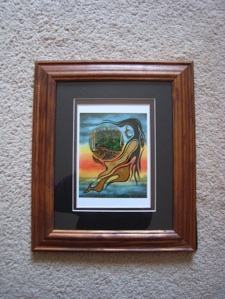
The Red Grandmother Moon has brought in her wake more snow and storms. We are now at the eve of the Spring Equinox, and the birthing of a new cycle of time. This year, Easter is aligned with the Full Moon and Equinox - Elena tells me that the last time this happened was in 1913, the year Grandfather was born. That was also the eve of the First World War. March 21 is also the International Day for the Elimination of Racism and Zenophobia, inspired by the transformative events in South Africa.
Friends have organized a party in honour of this sacred moment in Mother Earth’s cyclical calendar, to plant seeds for A Circle of All Nations, A Culture of Peace.
We hope you will be able to join us!
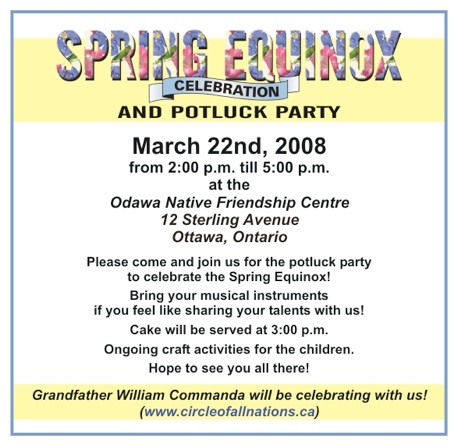
ARCHIVE BLOG
Spring New Moon - We try blogging again!

7 March, 2008

